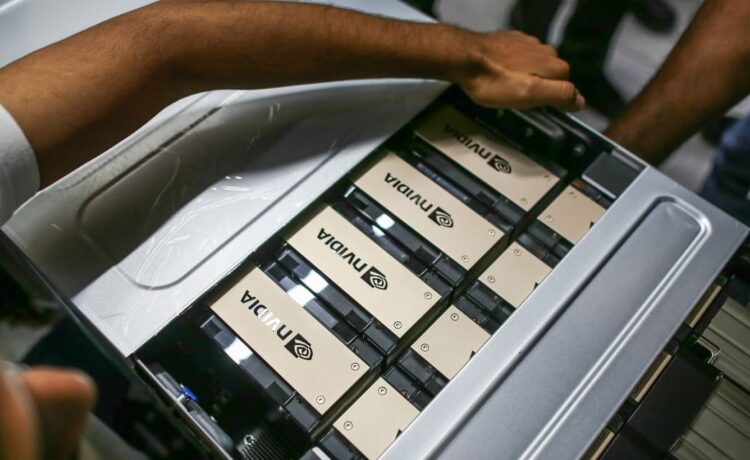The market cap of AI chip maker
passed $3 trillion in the second quarter. Because microchips are made from silica, it’s tempting to say that Nvidia’s entire capitalization is built on sand. But nothing is firmer than Wall Street’s belief in artificial intelligence. The behemoth’s stock surged 37% in the past three months and almost 200% in the past year.
The question for fund managers now is whether it’s all a bubble. Consider that at $3 trillion, Nvidia’s market value is greater than the $2.3 trillion national net worth—all the assets minus all the liabilities—of Sweden, a nation of 10.5 million people. It’s almost on par with Africa’s 2023 $3.1 trillion gross domestic product. Nvidia, which employs 29,600, is now worth more than $100 million per employee.
Most funds that have avoided or underweighted Nvidia and other AI-related stocks lagged behind this past quarter, and those that have overweighted them outperformed. It’s no surprise, then, that
ProFunds Semiconductor UltraSector,
which leverages its Nvidia and other chip stock exposure by 150%, was the quarter’s best-performing mutual fund, up 31%, and 108% overall in 2024. The best-performing exchange-traded fund in the quarter was the double-leveraged Nvidia one—
Direxion Daily NVDA Bull 2X Shares
—up 69%, and over 300% in 2024.
Anyone who believes such blistering performance can continue indefinitely should probably have their own chips examined.
Still, given Wall Street’s desire to replace all humans with machines that are cheaper and more efficient than us and don’t cry when they’re terminated—or terminating us?—one must take the AI megatrend seriously.
Advertisement – Scroll to Continue
There are excellent funds on both sides of the Nvidia trade. The $111 billion balanced fund
first established a Nvidia position this March, according to Morningstar. Though it’s a 1.5% position, it’s a top-10 holding, large for this well-diversified fund. It’s also historically significant.
Daniel Pozen, who manages the fund’s equity sleeve, has made a conscious effort to shift away from the fund’s previous value-oriented strategy. Nothing says growth like Nvidia, the absence of which, Pozen acknowledged in the fund’s November 2023 annual report, “held back relative returns.” The fund is beating its peers this year and this quarter in part because of that shift.
T. Rowe Price Capital Appreciation,
which is run by arguably the best balanced fund manager, David Giroux, has started reducing its Nvidia position, cutting it by 26% in 2024’s first quarter, according to Morningstar. In the fund’s latest annual report letter in December, Giroux noted: “While we own Nvidia today, the range of potential outcomes is quite large, and it is not the best risk-adjusted way to play AI from here, in our view.” He worries about competitors cutting into Nvidia’s profit margins. The fund’s latest disclosed Nvidia weighting was 1.9%. Year to date, Capital Appreciation is still ahead of its peers, up 7.1% versus the Moderate Allocation category’s 6.6, but trails Vanguard Wellington’s 8.2%.
The biggest diversified stock fund beneficiaries of the AI craze have been Large Growth funds, up an average 4.9% this quarter and 17.6% so far in 2024. The best mutual fund performer in the category this quarter,
gained 11.6%, but it has a high 2.63% expense ratio and often leverages its exposure with ETFs like
It’s too risky and overpriced for most investors.
More interesting is the $32 billion
with a 10.4% return this past quarter. Its Nvidia weighting increased from 8.7% as of April 30 to 10.8% as of May 31. That’s more than the weighting of every active growth manager’s bête noire, the $285 billion
Advertisement – Scroll to Continue
which tracks the Nasdaq 100 index and has 7.9% in Nvidia. Fidelity OTC is one of the few Large Growth funds to provide any meaningful competition to the Nasdaq 100 ETF long term. It’s winning this year, up 24.9% versus the ETF’s 17.3%. Yet Fidelity still lags behind the QQQ’s surreal 18.7% 10-year annualized return with its 17.9% one.
Perhaps more attractive than Fidelity OTC is the $76 billion
fund, which reopened to new investors this quarter after 20 years of being closed. Morningstar categorizes it as Large Blend, although it’s more of a growth fund. It has only a 1.8% Nvidia weighting, but has done well recently because of its large weighting—now 12.7%—in
Lilly is surging because of its diabetes drug Ozempic, which those who can afford it are gobbling up to lose weight.
Like Fidelity OTC, Vanguard Primecap has been a terrific long-term fund, yet it also can’t keep up with the QQQ ETF’s returns. Primecap has suffered $3.5 billion in outflows in the past year, according to Morningstar. If you’re a Nvidia fan, the QQQ might be good enough for exposure, as would other cheap growth ETFs like
iShares Russell Top 200 Growth,
11.9% Nvidia, or the more diversified
10.6% Nvidia. Or, you can just buy the stock directly.
One thing Wall Street pros often say is to never fall in love with a stock. Fund history is littered with managers who bet and lost the farm on one name. The most famous might be Robert Goldfarb of the
who had a huge position in
Maybe investors shouldn’t let Nvidia be their crush, either. There are other fund categories doing well: India equity funds, up 9.3% in the quarter; precious metals, up 6.2%; and even utilities, up 3.5%. It’s hard to think of a better diversifier for a stock like Nvidia than utilities.
Advertisement – Scroll to Continue
Email: [email protected]
















